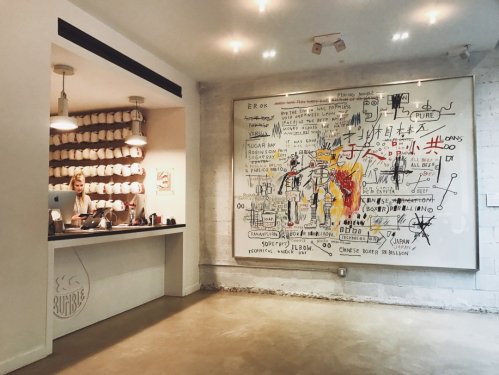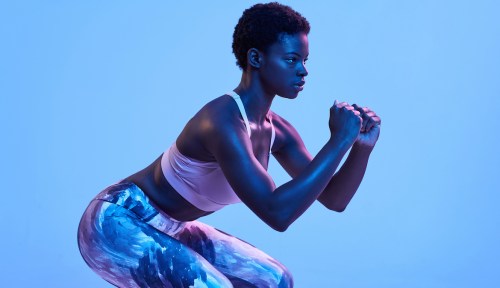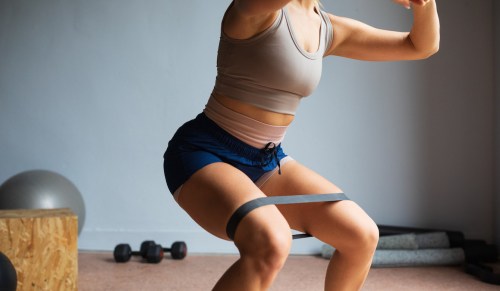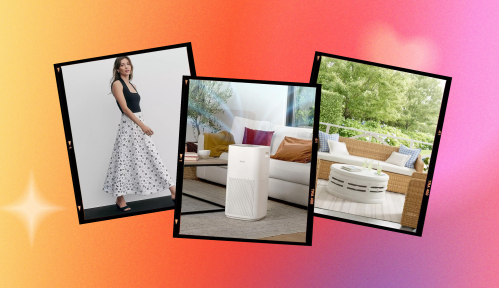Much like a blind date, a studio’s first impression can make a big impact on how you walk away feeling about the overall experience. And in an increasingly competitive industry, brands are being as mindful when it comes to the interior design of their spaces as they are the workouts being offered inside of them.
That could mean luxe shower products in the locker rooms like at Barry’s Bootcamp. Or, incorporating art, which is what SoulCycle did when it opened a new studio in midtown Manhattan in 2017. “More than 20 orbs were positioned throughout [the lobby], and riders were encouraged to place their hands on [their] surfaces to see a ‘reflection of their soul’ based on the colors and vibrations that show through,” says Alan Cooke, SoulCycle’s vice president of design, who added that a new lobby experience is coming soon.
Just like the future of fitness is digital, the future of brick-and-mortar studios will likely be, too.
If studios are already paying this much attention to detail today, what’s next? That’s a question I posed to Shelly Lynch-Sparks, founder of Hyphen, an interior design firm that’s worked with clients including MNDFL meditation studio in New York City, Hit House (a new Muay Thai boxing studio in Manhattan), and Classpass’ HQ. Just like the future of fitness is digital, the future of brick-and-mortar studios will likely be, too.
“We’re constantly thinking of ways we can design for tech,” says Lynch-Sparks. When working on the interior Hit House, she says she was “adamant” about easy connectivity with outlets and USBs. “I hate not having all the things I want right in front of me when I’m in a workout space,” she says.
Other design elements to (potentially) be on the lookout for—if not now, soon: blissfully fast and orderly check-in processes, truly high-tech experiences, and custom-scented locker rooms. (Yes, seriously.)
Here are 6 more predictions from design pros about the fitness studio experience of the future.

1. Personalized lockers
No longer are lockers being looked at as smelly caverns to store your stuff during a sweat sesh. Michael Bordes is the president of Jedson Company, a construction firm that’s worked with buzzy NYC studios such as Rumble, SLT, Pop Physique, and Bari Studio. And he tells me that he’s recently seen an uptick in such clients requesting “more upscale locker rooms and bathrooms that are scented. It’s similar to what some hotels with signature scents are doing; the scent is generated [through the ducts] into the ambient air.” So, not only will you be buying into a studio’s signature workout, but perhaps its signature scent, too, as brands invest even more into selling a lifestyle—not just a class.
Oh, and having to pay for a lock because you forgot yours (or having to remember your four-digit combo after a particularly blissful yoga class) might soon be a thing of the past, as well. “With digital lockers, people forget their code and get locked out, which is problematic, but I think [soon] it could be your thumbprint, or some part of your body, instead of your code” says Lynch-Sparks. “I’m not sure how far out that will be, but it could be soon, considering we already have it on the iPhone.”
2. Heightened reality
“I think we’re going to start to see crazy stuff with virtual reality,” Lynch-Sparks says. VR has already popped up in the at-home spinning experience VirZOOM, and Icaros’ VR-fueled core-toning machine and she predicts it’ll show up next in group workout classes.
“VR is on the verge of really taking off, and there are some corporations putting big money behind it,” she says. “That’s definitely going to be big.”

3. A mellower arrival
“We’ve spent a tremendous amount of time reviewing our check-in experience to set ourselves up for thoughtful digital integration,” says Cooke. Soon you can expect a more speedy, simplified sign-in process at SoulCycle, and studios like it.
“Imagine a set of tablets when you arrive, and other self-service options to streamline a large group of individuals arriving at once, with helpful service professionals available as needed,” says Sarah Abdallah, an interior architect and designer, whose been tasked with incorporating wellness elements for clients like the Ritz-Carlton and Neuehouse, a private club and co-working space. Translation: a less frantic clamoring of leggings-clad folks scrambling to make it in time for the warm-up. “Technology can be integral in helping people make the transition from the chaotic outside world to going within,” Abdallah says.
4. Next-level lighting for mindfulness
“What we’re able to do with LED lights has changed so much over time” says Lynch-Sparks, noting how lighting can be seamlessly controlled via a phone app now. “Where LED goes next will be interesting: Being able to control lighting in the middle of a workout, and having it timed perfectly to the music, or just think about how advanced a class could be if it was rainbow-lit and then dimmed down to a sunset or something, with the entire experienced controlled lighting-wise, instead of blowing out a candle.”
Bordes also expects light and sound therapy to take off in boutique fitness settings. Some spots, like ChromaYoga in London and Woom in New York City, already incorporate light therapy into the workout experience, by, say, wall projections intended to resonate with the body’s internal cellular patterns. Studios of the future could take things further. “Imagine vibrational therapy incorporated into the floorboards, grounding the body into the space and communicating to the cells that this is a time to relax and release,” Abdallah predicts. Talk about taking a holistic approach to a whole new level.

5. Ultra-mindful construction
The polished floorboards that you’re quivering a few inches above for every gloriously grueling second of the Hundred in Pilates can, and increasingly will, be sourced resourcefully, Abdallah says. That means using Forest Stewardship Council certified wood, or finding and repurposing raw materials from a demolition site. And there doesn’t have to be any compromise aesthetically just because a studio is eco-friendly. “Forward-thinking design is moving away from raw wood and toward very polished, soft, and streamlined uses of traditional materials,” she says.
6. More cool signs for the ‘gram
Unsurprisingly, Instagram-worthy design touches are a must for Lynch-Sparks when she’s working on a fitness studio. “We design opportunities for signage and branding to be a part of the experience,” she says. But ubiquitous neon signage in boutique studios may soon be a relic. “I think neon signs are going to go. They’re really hitting their high now, but we’re trying to step away from that. It’s an eye-grabber, but we can be more creative and think outside the box.”
Lynch-Sparks anticipates that motivational phrases lining the walls and common spaces of studios will likely stick around. Instead of a glowing sayings, though, you might see “a wall painted neon green, slapped with a black logo or hashtag on it. I think that’s way more effective,” she explains. That bright, but not blinding approach is already happening: Bordes says he’s recently been getting requests to build out selfie walls with different backdrops for fitness clients. So, does that mean it’s safe to say that when it comes to fitness studios, the future looks bright?
For more, get the 411 on light-therapy yoga and study up on the wellness and fitness tech innovations that could seriously upgrade your life.
Sign Up for Our Daily Newsletter
Get all the latest in wellness, trends, food, fitness, beauty, and more delivered right to your inbox.
Got it, you've been added to our email list.









